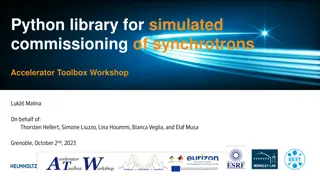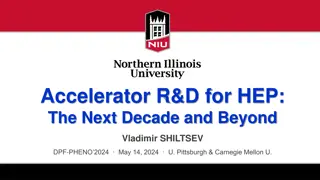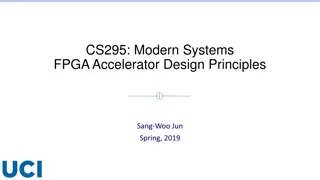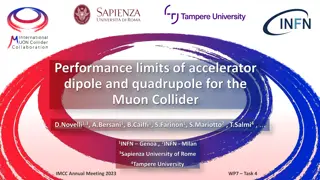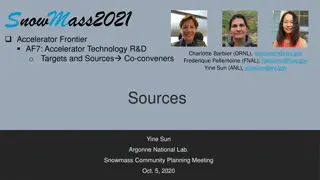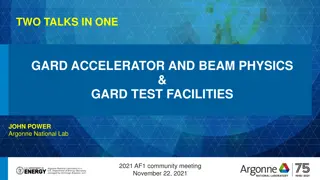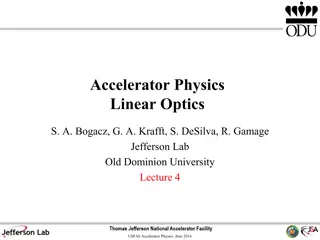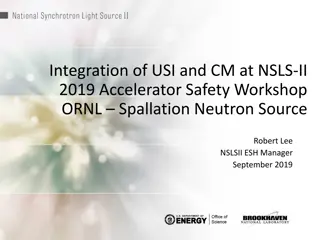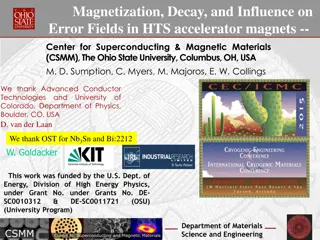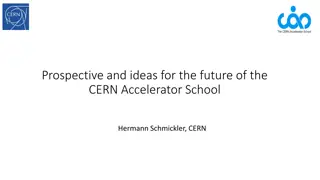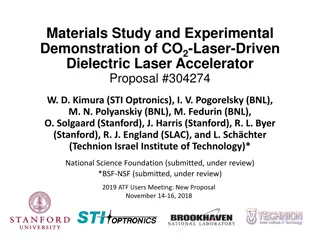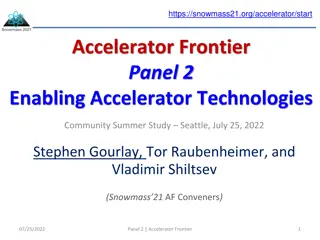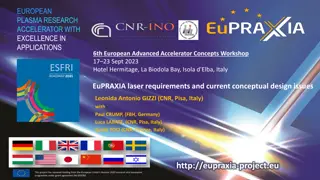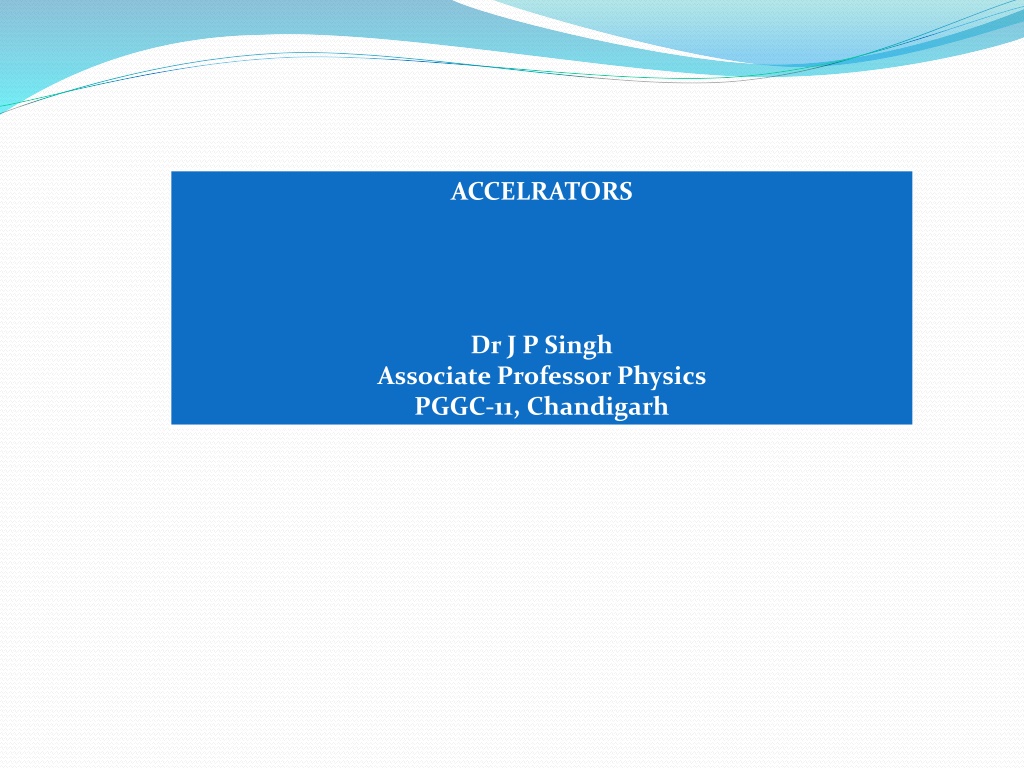
Linear Accelerators and Cyclotrons: Principles and Advantages
Discover the principles and advantages of linear accelerators and cyclotrons in the field of particle acceleration. Linear accelerators use alternating electric fields, while cyclotrons accelerate charged particles in circular paths by dropping them over potential differences. Both have distinct advantages and disadvantages, making them essential in achieving high-energy particle beams.
Download Presentation

Please find below an Image/Link to download the presentation.
The content on the website is provided AS IS for your information and personal use only. It may not be sold, licensed, or shared on other websites without obtaining consent from the author. Download presentation by click this link. If you encounter any issues during the download, it is possible that the publisher has removed the file from their server.
E N D
Presentation Transcript
ACCELRATORS Dr J P Singh Associate Professor Physics PGGC-11, Chandigarh
Linear accelerator Principle.The working of a linear accelerator is based on the following two facts: (i) When a charged particle is subjected to an alternating electric field, it is accelerated during one half cycle. (ii) The electric field inside a hollow charged conductor is always zero and a charged particle moves inside it with uniform velocity.
For the acceleration of the ion, the time of transit of ion through the length of a tube must be equal to half the time period of the high frequency alternating voltage supplied by the oscillator. So, each tube must be longer than its preceding one because the accelerated ion travels increasingly longer distance in the same time. If q and m respectively represents the charge and mass of the ion and V is the average value of potential difference then its velocity vn while entering nth tube is given by 1 mv nqV = 2 n 2 nqV 2 = vn m n The velocity of the ion is directly proportional to The time taken by the ion to pass through all the tubes is same and is T/2. Therefore, the length of nth tube is given by T n= l v n 2
nqV 2 = ln T m ln As q, m, V and T are constants, therefore n i.e. the lengths of the tubes1, 2, 3 .are in the ratio of 1, 2 3 Advantages: (1)Linear accelerators are economical when very high energies are required. (2) These can provide well collimated beam of accelerated, charged particles with high intensity Disadvantages: The major disadvantage of the linear accelerator is its large length. To accelerate the charged particles to high energies, number of cylindrical tubes are to be used.
cyclotron A Cyclotron is a device that accelerates charged particles in a circular path by repeatedly dropping them over a potential difference Principle: It is based on the principle that charged particles can acquire high energy when they are repeatedly passed through an accelerating electric field along a closed path. Particle acceleration is achieved using an RF field between dees with a constant magnetic field to guide the particles.
Let m = mass of ion to be accelerated B = magnetic field q = charge on the ion v = velocity of ion r = radius of semi-circular path The centripetal force required by the ion to move in a circular path is provided by The perpendicular magnetic field B. So, 2 mv = qvB r mv r= qB If t is the time required to complete the semi-circular path, then = . 2 1 2 r r m = = t v v qB
Cyclotron frequency: 2 m = 2 = T t If T is the time period of the charged particle, then Bq 1= Bq 2 = So, the frequency of revolution, T m Bq = 2 = And angular frequency is given by, m Maximum energy of particle: 1mv = 2 max The final energy of the charged particle is given by, E max 2 2 max mv Bq = = Bqv v max r Now max max max r m 2 2 2 1 B q r = max E Hence, max 2 m
Limitations of Cyclotron: (i) Uncharged particles can t be accelerated. (ii) Only heavy charged particles like protons, deutrons, -particles etc. can be accelerated. Electron can t be accelerated because of its small mass and a small increase in energy makes it move with very high speed, as a result it goes quickly out of track. Advantages: (i) It requires comparatively low voltage source for producing high energy particles. (ii) The accelerated charged particles produced by cyclotron are used for producing high energy particles like neutrons by collisions. (iii) The particles produced are used in artificial transmutation of elements.
betatron The betatron is essentially a transformer with a torus-shaped vacuum tube as its secondary coil. An alternating current in the primary coils accelerates electrons in the vacuum around a circular path. The betatron was the first important machine for producing high energy electrons.
The induced e.m.f produced in the circuit by changing magnetic fluxis given by Faraday s law. d = dt The work done on an electron of charge e in one revolution is given by W = charge on electron induced e.m.f d = = W e e dt work done = F Now, tan dis ce travelled in one revolution / W 2 ed dt = = F 2 r r
2 mv = Also Bev r = or p erB dp dB = or er dt dt dp dB = = Now F er dt dt / ed dt dB = Combining all equations, we get er 2 r dt d d = 2B 2 ( ) or r dt dt This equation is called Betatron condition or flux condition. This shows that the rate of change of magnetic flux within the orbit radius r is always twice that it would have been if the magnetic field intensity were uniform thoroughout thr orbit.
Synchro-cyclotron The Synchro-cyclotron overcomes the difficulties of cyclotron by decreasing the oscillator frequency to compensate for the changing mass.
The machine in which magnetic field is kept constant and the frequency is varied is known as Synchro-Cyclotron. It can accelerate -particle upto 400MeV, deutrons upto 200MeV and protons upto 350 MeV. Advantages: (i) The efficiency of the oscillator is high at low r.f voltage. (ii) High magnetic pole flux density is obtained by reducing the gap between the magnetic pole faces. Disadvantages: (i) Electrons can t be accelerated. (ii) The output beam current is very small (1 A) because a small fraction of injected ions are admitted into expanded phase stable orbits of maximum radius and energy.
synchrotrons The orbital accelerator which employs the increasing magnetic induction B in an orbit of constant radius is called synchrotron. There are two types of synchrotrons: (i) Electron synchrotron (ii) Proton synchrotron
Electron synchrotron: = + 2 2 2 o 4 E p c m c The energy of electron having rest mass mo is given by 2 . 0 51 m c MeV Since o 2 E m c o E pc = or E eBrc 1 1 = = And the frequency of oscillation is given by 2 r T c c = 2 r
Proton synchrotron: It is similar to electron synchrotron and is sometimes called Bevatron. It can be used to accelerate protons, alpha particle, deutrons etc. The frequency of revolution is given by 2 eBc = + 2 2 ( ) K m c o In the presence of four straight sectron each of length l, we get 2 2 eBc r + = . + 2 2 ( ) 2 ( 4 ) K m c r l o o Since total energy, = + = + 2 2 2 2 o 4 E K m c p c m c o
+ + = + 2 2 2 o 4 2 2 2 o 4 2 k m kc m c p c m c o = + 2 2 o 4 ( ) eBr c m c o 1 + 2 [ ( 2 )] K K m c 2 = o or B er c o 1 + 2 [ ( 2 m )] 1 c K K m c 2 = , . o we get + + 2 2 ( 4 ) K c r l o o




